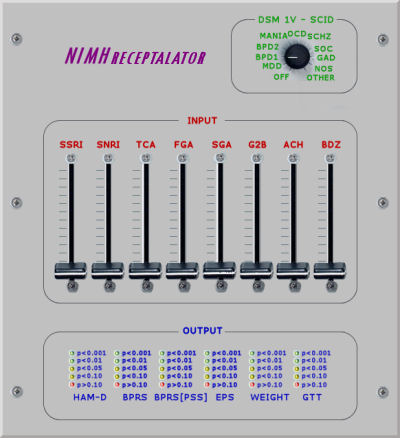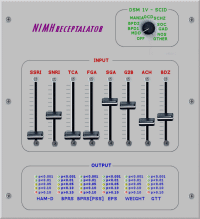
I realize as I’ve read through the Psychopharmacology literature recently and looked over the Clinical Trials scene that I am developing an unsettling view of people. Drawing it out on paper [above], it looks kind of simplistic. I probably could’ve added Lithium [Li] and anticonvulsants [DPK] to the input; put in a dial for trial type [Double Blind, Open Label, Crossover] and another for number of subjects; maybe added in a trial duration slider; even beefed up the range of output assessment scales. Then again, those could be enhancements for the NIMH·receptalator II.
 I even had a fantasied study – sort of a flow diagram. I’d start with a large bunch of depressed people [MDD][SCID->DSM IV] and put them on antidepressants [SSRI, SNRI, or TCA] giving the ones on SSRIs a Benzo [BDZ] to prevent akithisia. Then with the non-responders [HAM-D], I’d add an Atypical Antipsychotic [Second Generation Antipsychotic][SGA]. I’d treat the ones that developed Extrapyramidal Symptoms [EPS] with an Anticholinergic [ACH]. In the responders who developed weight gain or an abnormal glucose tolerance [GTT], I’d add on a Glucocorticoid antagonist [G2B]. Conceivably, I could have some single person with Norepinephrine, Dopamine, Serotonin, Acetyl Choline, Benzodiazapine, and Cortisol receptors all tweaked in one direction or another at the same time. Now that’s some treatment!
I even had a fantasied study – sort of a flow diagram. I’d start with a large bunch of depressed people [MDD][SCID->DSM IV] and put them on antidepressants [SSRI, SNRI, or TCA] giving the ones on SSRIs a Benzo [BDZ] to prevent akithisia. Then with the non-responders [HAM-D], I’d add an Atypical Antipsychotic [Second Generation Antipsychotic][SGA]. I’d treat the ones that developed Extrapyramidal Symptoms [EPS] with an Anticholinergic [ACH]. In the responders who developed weight gain or an abnormal glucose tolerance [GTT], I’d add on a Glucocorticoid antagonist [G2B]. Conceivably, I could have some single person with Norepinephrine, Dopamine, Serotonin, Acetyl Choline, Benzodiazapine, and Cortisol receptors all tweaked in one direction or another at the same time. Now that’s some treatment!
Obviously, I’m being facetious with my NIMH·receptalator, but I’m trying to make a serious point. If you browse around in clinicaltrials.gov or the NIH RePORTER looking at the studies in Psychiatry, a large portion of them fit into some version of my fantastic NIMH·receptalator machine – lets try this or that end-plate neurotransmitter and/or receptor altering chemical in this or that condition and see what happens to this or that scale. It’s a whole branch of science unto itself with its own supporting industry.
Thomas Kuhn would agree. So would Voltaire, to whom is attributed the observation that physicians gave drugs, about which they knew little, to cure diseases, about which they knew less, to patients about whom they knew nothing.
That pretty much sums up the current scene, which is driven by structured interviews in lieu of listening to patients; by rote diagnostic algorithms in lieu of differential diagnosis; and by outcome assessments performed over the bloody telephone, as in the STAR*D trial.
I found the quote from Voltaire in an insightful recent essay here:
http://qjmed.oxfordjournals.org/content/104/2/179.full?etoc
And that shift is to take a look at the Finland stats in Robert Whitaker’s new book, “Anatomy of an Epidemic”. Ask yourself “why is there a mental health epidemic only in America?” you’ll know the answer. Just in case: there isn’t one. It’s all pharma funded induced stats and that includes the new DSM5.
YES, there is NO silver bullet, no new better drug. There never was.
Your NIMH-receptalator bears a striking resemblance to the screenshots of CompTMAP, circa 2004, published in an article by Madhukar Trivedi and colleagues here:
http://www.ps.psychiatryonline.org/cgi/content/full/55/8/879
Unsurprisingly, Trivedi’s team encountered barriers when they tested the machine in the real world. Read all about it here:
http://www.biomedcentral.com/1472-6947/9/6/prepub
Bernard,
Thank you ever so much for the Voltaire quote. And Mickey, thanks for the fantasy.
AMEN to the post and AMEN to the Voltaire quote. It’s high time for a paradigm shift.